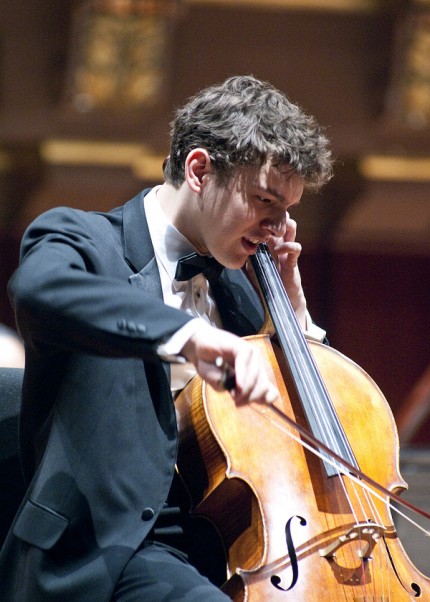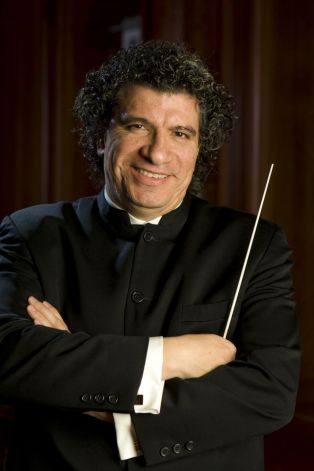Cellist Cabezas strikes sparks on a rainy night at Grant Park

Another Wednesday night, another rain-drenched concert at Millennium Park.
Exactly two weeks after a Grant Park Orchestra performance was delayed and eventually cancelled due to a raging thunderstorm, the meteorological gods proved less than beneficent once again. On an unseasonably cold July night, the persistent rain sent those in the Pritzker Pavilion scurrying for a spot Wednesday beneath Frank Gehry’s majestic yet leaky metal billows. The wet lawn was left almost deserted except for a few hardy souls who camped out underneath their hoods and umbrellas.
If the program, led by Costa Rican conductor Giancarlo Guerrero, wound up offering rather mixed rewards, there was no doubt about the evening’s highlight, provided by local cellist Gabriel Cabezas.
Saint-Saëns’ Cello Concerto No. 1 is not the deepest concertante work ever written, but in its unerring craft and attractive mix of good tunes and fizzing virtuosity, the French composer’s 19-minute esprit can prove irresistible in the right hands.
As it was with Cabezas. Just 21 years old, the Chicago-born Curtis graduate made an inspirational lakefront festival debut. With a warm, commodious sound and sterling technique, the cellist fairly vaulted through the myriad challenges of the outer movements with firmly projected tone and bracing clarity of articulation, unfazed by the damp, chilly night.
Cabezas also showed himself fully in synch with the rhapsodic element, tackling Saint-Saëns’ lyrical lines in a sweet cantabile style. Some inartful balancing in the first movement apart, Guerrero led the orchestra in an alert accompaniment, nicely bringing out the lilting delicacy of the central Allegretto.
Another lightweight French work closed the evening, Poulenc’s suite from his ballet Les biches. The music may be pure fluff a la francais but it’s entertaining fluff nonetheless. If the music’s charm and sly wit weren’t always in evidence, Guerrero led a polished and energetic performance of Poulenc’s confection with especially snappy trumpet playing in the ersatz Baroque of the opening Rondeau.
The first half was devoted to a single work, the Chicago premiere of Richard Danielpour’s Darkness in the Ancient Valley. Guerrero conducted the world premiere in 2011 with his Nashville Symphony Orchestra.
Though born in the U.S, Danielpour’s symphony reflects his background and conflicted lineage as a Persian Jew, particularly an unhappy year spent in Iran as a child. Cast in five movements with a setting for soprano of a Rumi text in the finale, the composer calls Darkness in the Ancient Valley a “secular liturgy,” describing it as the work “of an American composer with a Middle Eastern memory.”
Danielpour is a prolific and gifted composer, as shown in such works as the affecting piano trio, A Child’s Reliquary. Yet Darkness in the Ancient Valley is not one of his more successful works.
Without doubting the composer’s sincerity or depth of feeling, Danielpour’s symphony doesn’t convey much of either in a musically compelling or emotionally communicative way. In fact, Danielpour’s populist idiom seems completely removed from any natural or idiomatic Middle Eastern element or sensibility, except in the most superficial manner.
Unfortunately, the music suggests more of the hoary cliches of 1950s silver-screen Biblical epics in the prevailing percussive bombast and sinuous quasi-muezzin woodwind solos of the first two movements. The moody and introspective third section (“Benediction”) offers some respite yet loses direction in meandering fashion, while the ensuing “Profanation” movement displays some shameless armed robbery from “The Death of Tybalt” section of Prokofiev’s Romeo and Juliet. Danielpour’s Rumi setting is awkward and unconvincing and the plodding final movement seemed to go on forever, making for an especially uninspiring coda.
Soprano Tracy Cantin sang with commitment in the finale’s vocal setting but her edgy top notes, at least as amplified, didn’t make much of a case for the music. Guerrero trained as a percussionist, which one can readily believe since his unsubtle conducting resulted in a performance that stayed on the near side of loud, reveling in the sonic overkill rather than trying to artfully finesse the score’s weaknesses. The Grant Park musicians responded with polish and professionalism.
Posted in Performances





